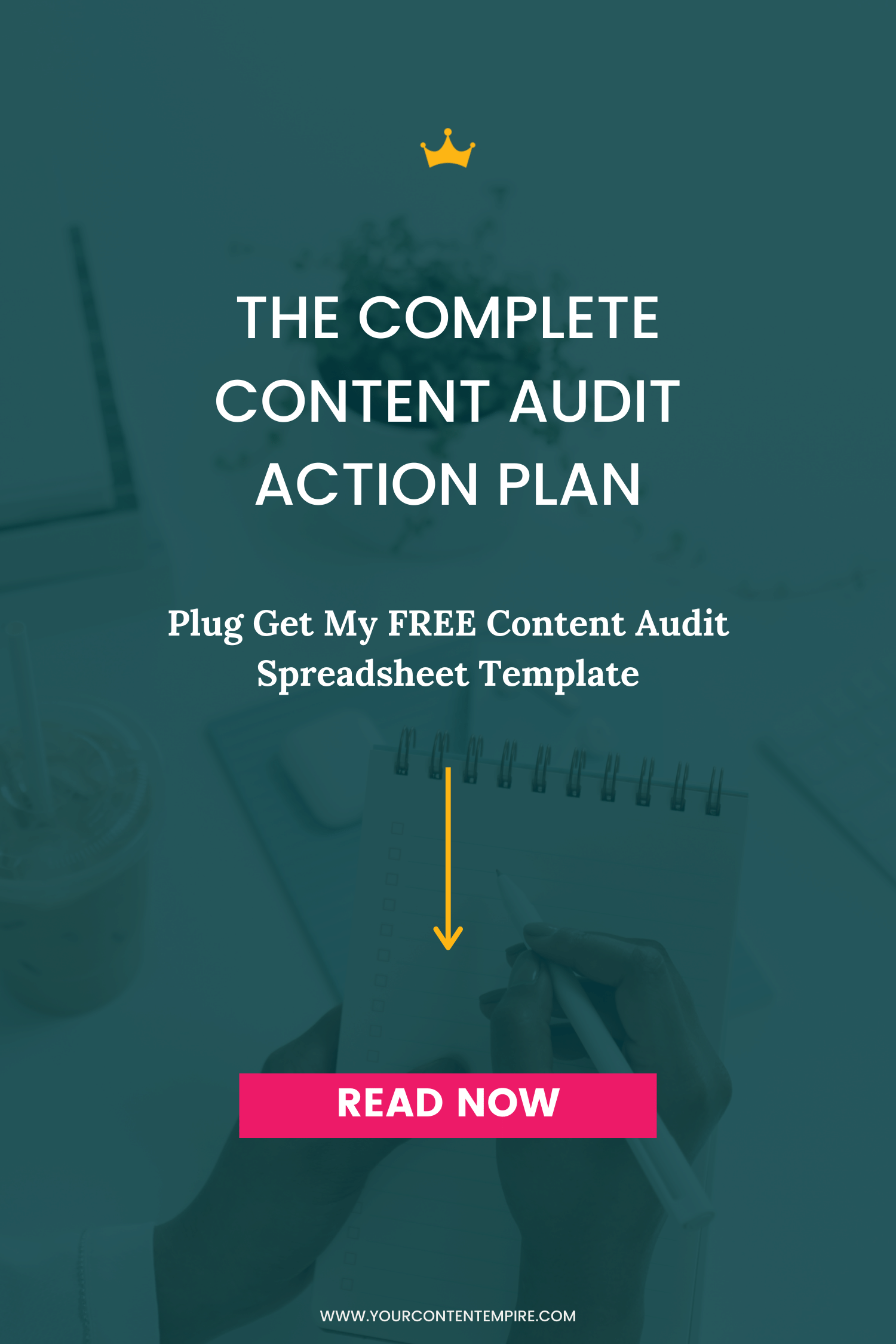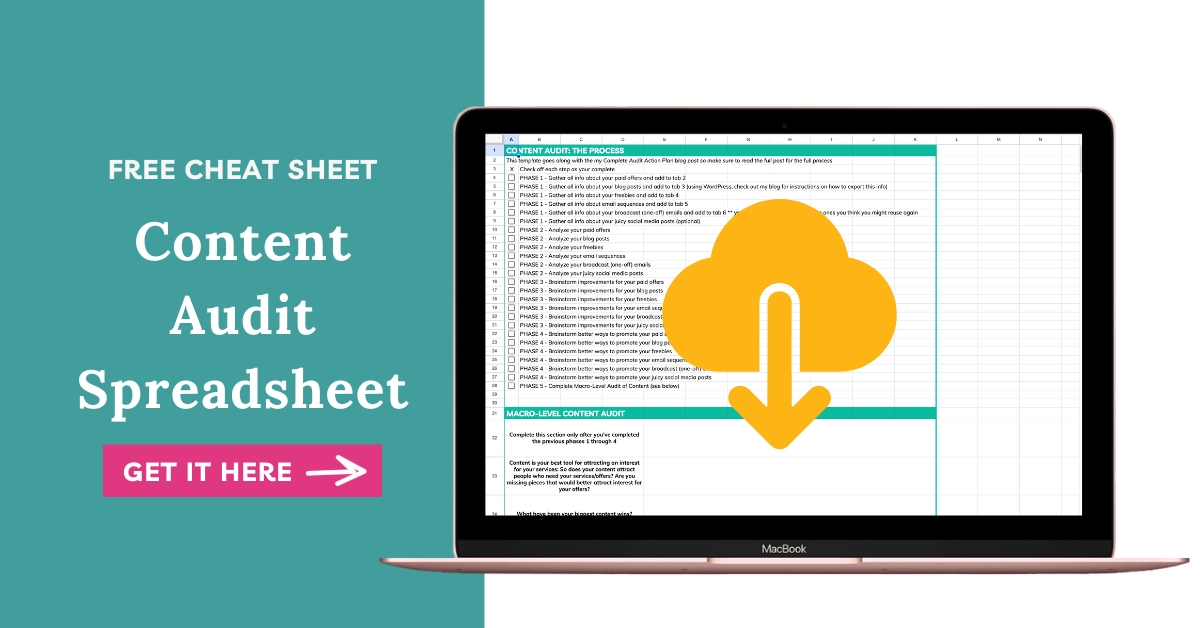I recently had the opportunity to do a massive audit of my content while I was preparing the new website and rebranding every single blog post and freebie I’ve ever published.
And while it was a TON of work, it was such a nostalgic trip down memory lane, and I ended up with so much clarity about what I've already created and what is missing from my content library. Win-Win-Win =)
I'm not saying that you have to overhaul everything, but I do wholeheartedly believe you should do an audit of your content at least once a year and that the end of the year is the perfect time to do it because it'll allow you to end the year with a clean slate.
So in this post, I'm going to walk you through a process that I use to conduct this annual content audit…
Luckily the most time-consuming part of this process only has to be done once, and it'll be much simpler and quicker to keep up moving forward.
Also if you’ve already set up your content bank then prepare for easy street 😉
Phase 1: Gathering the Info for Your Content Audit
Phase one is to gather all of your content and begin documenting pieces of information about them.
I’ve put together a free spreadsheet to help you with this process:
This first phase is marked in the spreadsheet as phase 1 for each tab
START BY ENTERING YOUR PAID OFFERS
Even if these aren’t necessarily information-based offers, we still want to start with these as they’re what your content is geared towards selling and attracting an interest list for. For each of your offers, add the following info (tab 2 of the spreadsheet):
- Name of your offer
- Salespage, offer page or purchase link
- Price point
- Who this offer is for
GATHER ALL OF YOUR BLOG POSTS
(whether they’re written, audio or videos)
Your blog is at the heart of your content empire and usually your biggest collection of content. For each post, here's what you'll want to collect (and there's a space for each of these in the spreadsheet):
- Title
- URL
- Date Published
If you’re using WordPress, here’s a tutorial on how to export all of your content plus some information into your spreadsheet:
- From your dashboard, go to the plugins tab
- Click ‘Add New’ and search for the ‘Export Post Info’ plugin
- Install and Activate
- Find the plugin in your list and click ‘settings’
- Update the random string so that it’ll be something you can remember and find once you download the file (doesn’t have to be complicated, I just put YCE-BlogPosts-11202019)
- Save Changes
- Then you can download by clicking ‘click here’ near the top of the page
- Now upload the CSV file to Google Drive
- Right click on it and Open With > Google Sheets
- Copy and paste the information into the Content Audit Spreadsheet template
- You can now delete the plugin if you don’t need it anymore
GATHER ALL OF YOUR FREEBIES
(whether they’re bigger freebies, event-based freebies or smaller content upgrades)
Your next most crucial collection of content are your freebies. For each of these, try to collect these bits of info:
- Name of Freebie
- Access Link (where does someone download or access the freebie after signing up?)
- Category
- Opt-In Page (put the link if you have an opt-in page for it)
- Opt-In Form (what is the name of the form you’ve set up for this freebie in your email service provider)
GATHER ALL OF YOUR NEWSLETTERS
(start with sequences and then broadcasts)
Next, we want to collect your email newsletters because, especially if you've been in this content game awhile, these are excellent references for future emails. We're going to start with your sequences, those that are tied to products or freebies.
For the sequences gather the following for each email in the sequence:
- Subject line of the email
- Which sequence it belongs to
- Email # in the sequence
- Purpose of the email
- Link to email preview (some email service providers allow you to preview or forward the email content to someone with a link, if that’s possible, add the link in this column)
For the broadcasts gather:
- The subject line of the email
- Date sent
- Purpose of email
- Audience (who it was sent to)
- Link to email preview (some email service providers allow you to preview or forward the email content to someone with a link, if that’s possible, add the link in this column)
Just a tip: You might have HUNDREDS of these, so discern whether or not you might reuse these or use them as jumping-off points for future emails, so you don't need to collect every single one. For example: If you have a call reminder email for a group program, you likely don't need a copy of every single one.
OPTIONAL: GATHER YOUR SOCIAL MEDIA POSTS
This is an optional step, and I'd only recommend it if you have a social media platform where you usually publish juicy, original pieces of content (whether they’re live videos or long written posts), add these to the social tab
This might be a process that you use going forward. But I know for myself, I frequently find myself giving really detailed responses in Facebook groups that I love saving because if I see a similar question (happens all the time), I can copy and paste in my answer and not have to start from scratch.
So if you have these, duplicate the sheet in the Content Audit spreadsheet for each of these posts and collect these bits of info:
- Excerpt of the start of the content
- Link
- Category
If you want to save your Instagram posts, here's a way of exporting these:
- Log into your Instagram account from your desktop (not the mobile version)
- Go to your profile
- Click settings (the gear icon beside Edit Profile)
- Click Privacy and Security
- Under Data Download, click request download
- It can take up to 48 hours to receive
- Once you get the file – download it
- Unzip it – you'll have two folders: 1 with images and 1 with the HTML file
- Go to http://convertcsv.com/json-to-csv.htm
- Go to the second tab (choose file) and then press the ‘choose file’ button and find and upload your file
- Under step 3, press the ‘Convert JSON to CSV’ button
- When it’s finished converting, press the ‘download result’ button
- Upload the CSV file to Google Drive
- Right click on it and Open With > Google Sheets
- I’d start by going through the file and deleting anything you don’t want to archive (remember you’re looking for juicy response comments or value posts that you can repurpose into something else)
- Copy those remaining into a social tab on the Content Audit Spreadsheet template
- Now you can go back using the dates to find the links to these specific posts
If you want to export FB lives, here's a way of finding those:
- Log into your Facebook Account
- Click on the little downward arrow in the top right-hand corner, select settings
- Click Your Facebook Information from the sidebar
- Click Download your information
- You can narrow by date range, or select “all of my data”
- Format “HTML”
- Media Quality “Medium”
- You can go through and deselect any types you don’t need. I actually recommend doing separate exports for each info type even though you’ll have to wait between each export (the files will be easier to manage that way). And I will also usually only do exports of: Groups, Pages, Photos and Videos, Comments.
- Once you get the file – download it
- Unzip it – you'll have two folders: 1 with images and 1 with the HTML file
- Go to http://convertcsv.com/json-to-csv.htm
- Go to the second tab (choose file) and then press the ‘choose file’ button and find and upload your file
- Under step 3, press the ‘Convert JSON to CSV’ button
- When it’s finished converting, press the ‘download result’ button
- Upload the CSV file to Google Drive
- Right click on it and Open With > Google Sheets
- I’d start by going through the file and deleting anything you don’t want to archive (remember you’re looking for juicy response comments or value posts that you can repurpose into something else)
- Copy those remaining into a social tab on the Content Audit Spreadsheet template
**I always have minor formatting issues, especially with apostrophes, but luckily, once I whittle the posts down to just the ones I want to keep, I can fix those up easily.
Feel free to add separate sheets if you have other types of content you put out and want to catalogue.
Step 2: Micro-Level Content Audit
The second phase of the audit process is the micro-level review of your individual pieces of content. I suggest an analysis and improvement review.
Again, I’ve put together a free spreadsheet to help you with this process so sign up for it here:
This second phase will also be marked in the spreadsheet as steps 2 to 4 for each tab.
There are columns in the spreadsheet for each of these, and below is my recommendation for how to do this process:
ANALYZE ROUND:
We want to know more about each piece of content during this step, here is what I look at for each type:
Paid Offers:
- How many have you sold?
- How many inquiries or unique views has the point of sale gotten?
- What is the conversion rate (the number of sales divided by unique views or inquiries)
- Where does this fit into my customer journey? (see this post here to create your journey map)
Blog Posts:
- Where does this fit into my customer journey? (see this post here to create your journey map)
- What were the results of this piece? How many views? I'll plug the URL into Google analytics to pull that info.
- What is the keyword of the post?
- Is it SEO optimized?
Freebies:
- Where does this fit into my customer journey? (see this post here to create your journey map)
- What were the results of this piece? How many people have signed up for it? How many views of the opt-in page or form for conversion rate?
Newsletters – Sequences:
- What were the results of this sequence? How many people have been through it? How many people were opening and clicking each email? How many conversions to my sequence end goal?
Newsletters – Broadcasts:
- What were the results of this email? How many people has it gone to? How many people were opening and clicking each email?
Social Media Posts:
- From the posts that you’ve saved, what was the amount of passive engagement (likes/hearts, etc.)?
- What was the amount of active engagement (comments)?
- Some platforms have different metrics available (i.e., impressions) so there's a blank spot for other notes in the template
IMPROVEMENT ROUND:
The next step is to go through each piece again to come up with some ideas to improve the piece (excluding the broadcast newsletters). For each post, ask yourself:
Paid Offers:
- What area needs improvements based on the results? Could the point of sale (salespage, consult call) be converting better? Or is it that there haven't been enough people visiting the invitation or salespage?
- What are my initial ideas for things to test on the salespage, strategy, or offer itself?
Blog Posts:
-
- Ideas for improving the content or call-to-action – Is there anything that has changed in terms of my process or information I want to add to this post?
- Is the post SEO-optimized? Have I chosen and optimized for a specific keyword?
- Any formatting issues that I want to fix? Are all elements working on the page (forms, images, etc.)?
If you have a lot of posts – you could also start with 10-20 of your top-performing posts and work your way through them over time.
Freebies:
- Is there anything that has changed in terms of my process or information I want to add to this freebie?
- Any design issues I want to fix?
- Any copy/design changes to the sign-up page?
Newsletters – Sequences:
- Look at the open rates – are there any subject lines that need to be improved?
- Look at the click-through rates – do any emails need changing?
Newsletters – Broadcasts:
- Look at the open rates – are there any subject lines that need to be improved?
- Look at the click-through rates – do any emails need changing?
Social Media Posts:
- Can you see any ways to improve the engagement of this post?
- Can you see any opportunities to reuse this post again in the future?
PROMOTION ROUND:
The next step is to go through each piece again to analyze how you’ve promoted it and to jot down any other ideas for promotion. Here’s what to ask yourself for each piece:
Paid Offers:
- Link to the folder with promotion materials (copy and images)
- How have I primarily promoted this offer?
- What promotion methods do I want to experiment with or test for this offer?
Blog Posts:
- Link to the folder with promotion materials (copy and images)
- What promotion methods do I want to experiment with or test for this post?
Freebies:
- Link to the folder with promotion materials (copy and images)
- How have I primarily promoted this freebie?
- What promotion methods do I want to experiment with or test for this freebie?
Step 3: Macro-Level Content Audit
Now that you’ve done a comprehensive deep dive of your content, you have the perfect viewpoint to switch to thinking about the big picture.
Here are the questions to ask yourself:
- Content is your best tool for attracting interest for your services: So does your content attract people who need your services/offers? Are you missing pieces that would better attract interest in your offers?
- What has been your biggest content wins?
- Has your content gotten you closer to your goals? Sales? Leads? Traffic?
- How is the overall quality of your content?
Recommended 5-Day Content Audit Action Plan
Going into this process with a lot of content is definitely a two-sided coin:
On the one hand, you're going to get a lot of opportunities from cataloguing and reviewing it that'll help you leverage your old stuff (and spend less time creating new stuff).
On the other hand, it means this is going to take you longer.
Day 1: Gather and review all of your blog posts and offer info
Day 2: Gather and review all of your freebies
Day 3: Gather and review all of your sequences and emails
Day 4: Gather and review all of your social media posts and misc. pieces of content you want to track
Day 5: Complete the macro review of your content
Complete Your Own Annual Content Audit
It’s time to take this complete content audit plan and put action behind it. Schedule a date on your calendar for your upcoming audit. Start by gathering all the information you will need, and then move into a micro-level content audit, followed by a macro-level content audit.
By the time you’re done, you’ll be keenly aware of what content you do have as well as the gaps in content that exist, which will help propel you into what you can get excited about working on next.







